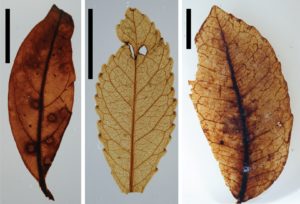Buried in sediment under an ancient crater lake in Central Otago, fossilised leaves have helped Kiwi researchers find the long-term effects of increasing CO2 levels on melting Antarctic ice.

Preserved in sediment containing no oxygen to aid decomposition, the sediment cores were essentially stacked annual layers similar to tree ring or ice cores. Studying the stomatal cells in the leaf fossils, and the carbon isotope ratios, the change in atmospheric CO2 over time was able to be tracked accurately.
Dr Beth Fox, a University of Waikato paleoclimatologist who was involved in the study, told Radio New Zealand that the ice melted from about 125% of the present day Antarctic ice sheet to 50%. “It’s a massive loss of ice, but the carbon dioxide levels do not stay high for the whole time, they actually go down and the ice appears to be able to keep on melting by itself presumably after it has been kick started by that carbon dioxide increase.”
Coverage of the findings included:
Radio NZ: Otago leaf fossils help solve major climate mystery
NZ Herald: Ancient crater lake in Central Otago offers clues for Antarctica